This is an AI Free Zone! Text created by ChatGPT and other Large Language Models is spreading rapidly across the Internet. It's well-written, artificial, frequently inaccurate. If you find a mistake on Spaceweather.com, rest assured it was made by a real human being. | | |
THE GEMINID METEOR SHOWER: Earth is entering a stream of debris from 3200 Phaethon, source of the annual Geminid meteor shower. Last night, Dec. 12-13, NASA cameras recorded 22 Geminid fireballs over the USA. Many more are coming. Forecasters expect the shower to peak on Dec. 13-14 with as many as 100 meteors/hour visible from dark sky sites. More: Observing tips; sky map.
THE GEMINIDS ARE STILL A MYSTERY: Every great mystery novel has an unexpected twist. Apparently the same is true of meteor showers.
A paper published in the Planetary Science Journal reports a surprising new twist in the mystery of the Geminids, a strong annual meteor shower that has puzzled astronomers for more than a century.
"Our work has upended years of belief about 3200 Phaethon, the source of the Geminids," says co-author Karl Battams of the Naval Research Lab. "It's not what we thought it was."
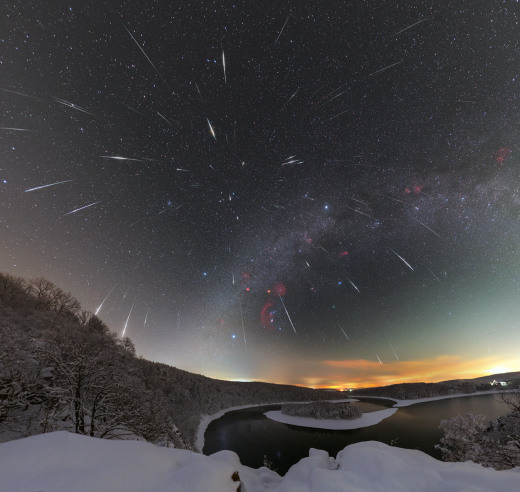
Above: Geminids over the Czech Republic in 2018. Credit: Petr Horálek
The Geminids peak every year in mid-December, scattering hundreds of bright meteors across northern winter skies. Numerically it is the best meteor shower of the year.
As meteor showers go, Geminids are newcomers. They first appeared in the mid-1800s when an unknown stream of debris crossed Earth's orbit. Surprised, 19th century astronomers scoured the sky for the parent comet, but they found nothing. The search would continue for another 100 years.
Enter NASA. In 1983, the space agency's Infrared Astronomical Satellite (IRAS) found an object now called "3200 Phaethon." It was definitely the source of the Geminids. The orbit of 3200 Phaethon was such a close match to that of the Geminid debris stream, no other conclusion was possible. Yet here was a puzzler: 3200 Phaethon appeared to be a rocky asteroid.
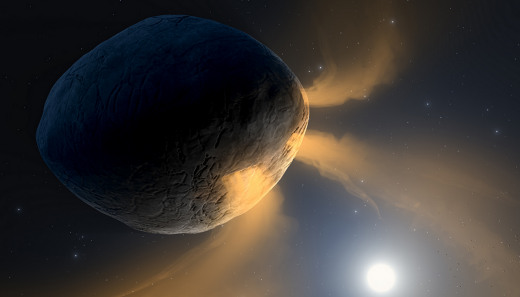
Above: An artist's concept of 3200 Phaethon spewing sodium gas
Asteroids are not supposed to make meteor showers. Unlike comets, they don't have tails and they don't spew meteoroids. Yet 3200 Phaethon was different. In 2009 and 2012, NASA's STEREO spacecraft caught 3200 Phaethon sprouting a tail when it passed close to the sun. Apparently, intense solar radiation was blistering meteoroids off 3200 Phaethon's rocky surface. Astronomers dubbed it a "rock comet," and the mystery was solved.
Or was it?
Astronomer Qicheng Zhang, lead author of the new paper, was never convinced. For one thing, the Geminid debris stream is massive (1013 kg), while the tail of 3200 Phaethon is puny, providing less than 1% of the mass required to explain the Geminids.
"The tail we see today could never supply enough dust to supply the Geminid meteor shower," says Zhang.
Zhang, Battams, and colleagues decided to take a closer look. Using coronagraphs on the Solar and Heliospheric Observatory (SOHO), they monitored Phaethon as it passed by the sun in 2022. Color filters on the spacecraft revealed no dust or rock. Instead, Phaethon's tail is made of sodium gas.
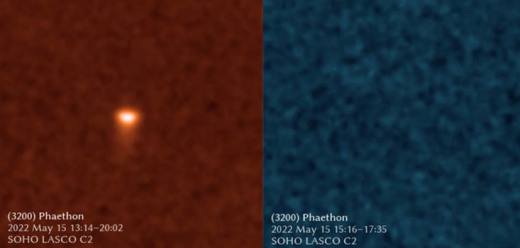
Above: SOHO's orange-filtered view, which can detect sodium, shows asteroid 3200 Phaethon glowing brightly.
And therein lies the twist. Meteor showers are made of meteoroids, not gas. Suddenly, the Geminids are a mystery again.
"We're back to square one," says Zhang. "Where do the Geminids come from?"
3200 Phaethon is still the main suspect. At least one study suggests that Geminid meteoroids are 1,000 to 10,000 years old. Perhaps something hit the asteroid millennia ago. Phaethon's rapid rotation makes it susceptible to sudden episodes of mass loss, so even a relatively small impact could create the necessary meteoroids.
The best way to test this idea is to look at the surface of Phaethon with a space probe. Japan plans to do just that. JAXA is building a spacecraft called DESTINY+ to fly by 3200 Phaethon for a closer look. Launch is scheduled for 2025.
Until then, the Geminids remain a beautiful mystery. Look for them streaking across the night sky this week!
Realtime Space Weather Photo Gallery
Free: Spaceweather.com Newsletter
CHRISTMAS GIFTS FROM THE EDGE OF SPACE: Christmas is coming. Are you looking for a far-out gift? Check out the Earth to Sky Store. It's filled with unique items that have flown to the edge of space onboard cosmic ray research balloons.

Carried aloft by giant helium balloons, these unique gifts have flown above 99.7% of Earth's atmosphere, experiencing space-like blasts of cosmic rays, extreme cold, and a wild ride parachuting back to Earth after the balloon explodes. Even Amazon doesn't carry items this far out.
Don't forget to enter coupon code "BUZZALDRIN" at checkout for a 10% holiday discount.
Far Out Gifts: Earth to Sky Store
All sales support hands-on STEM education
Realtime Aurora Photo Gallery
Free: Spaceweather.com Newsletter
Realtime Comet Photo Gallery
Free: Spaceweather.com Newsletter
Every night, a network of
NASA all-sky cameras scans the skies above the United States for meteoritic fireballs. Automated software maintained by NASA's Meteoroid Environment Office calculates their orbits, velocity, penetration depth in Earth's atmosphere and many other characteristics. Daily results are presented here on Spaceweather.com.
On Dec 13, 2023, the network reported 50 fireballs.
(22 Geminids, 18 sporadics, 5 sigma Hydrids, 3 December Monocerotids, 2 Comae Berenicids)
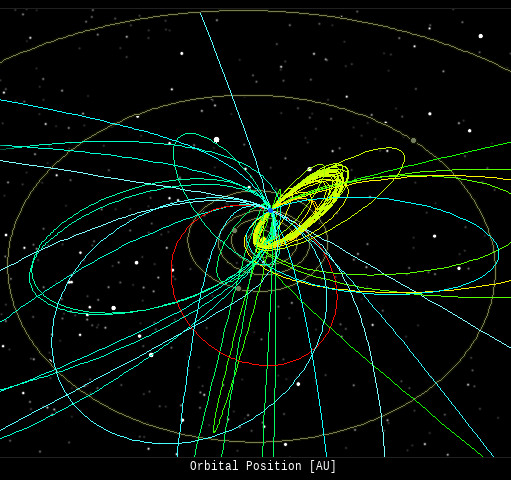
In this diagram of the inner solar system, all of the fireball orbits intersect at a single point--Earth. The orbits are color-coded by velocity, from slow (red) to fast (blue). [Larger image] [movies]
Potentially Hazardous Asteroids (
PHAs) are space rocks larger than approximately 100m that can come closer to Earth than 0.05 AU. None of the known PHAs is on a collision course with our planet, although astronomers are finding
new ones all the time.
On December 13, 2023 there were 2349 potentially hazardous asteroids.
 |
Recent & Upcoming Earth-asteroid encounters: | Asteroid | Date(UT) | Miss Distance | Velocity (km/s) | Diameter (m) |
| 2023 XE2 | 2023-Dec-08 | 13.3 LD | 5.9 | 18 |
| 2023 VF12 | 2023-Dec-08 | 13 LD | 4.1 | 22 |
| 2023 XQ10 | 2023-Dec-08 | 0.6 LD | 10.6 | 19 |
| 2023 XU5 | 2023-Dec-08 | 1 LD | 8.6 | 13 |
| 2023 XD3 | 2023-Dec-08 | 2.1 LD | 5.2 | 14 |
| 2023 WG | 2023-Dec-08 | 17.6 LD | 6.6 | 33 |
| 2023 XR | 2023-Dec-08 | 14 LD | 15.6 | 25 |
| 2023 XT3 | 2023-Dec-08 | 2.1 LD | 14.9 | 10 |
| 2023 XC | 2023-Dec-08 | 2.1 LD | 5.8 | 7 |
| 2023 XW5 | 2023-Dec-09 | 0.2 LD | 5.9 | 6 |
| 2023 XS3 | 2023-Dec-09 | 11.9 LD | 6.2 | 22 |
| 2023 XB4 | 2023-Dec-09 | 0.8 LD | 10.1 | 8 |
| 2023 XW2 | 2023-Dec-09 | 6.5 LD | 9.6 | 13 |
| 2023 XP2 | 2023-Dec-10 | 5.8 LD | 10.3 | 19 |
| 2023 WH | 2023-Dec-10 | 11.9 LD | 8.9 | 39 |
| 2020 HX3 | 2023-Dec-10 | 9.8 LD | 15.7 | 13 |
| 2020 XC3 | 2023-Dec-10 | 20 LD | 14.6 | 111 |
| 2023 XH3 | 2023-Dec-10 | 4.6 LD | 15.1 | 14 |
| 2023 XT4 | 2023-Dec-10 | 4.4 LD | 8.9 | 16 |
| 2023 XP1 | 2023-Dec-11 | 15.2 LD | 9.6 | 40 |
| 2023 XH2 | 2023-Dec-11 | 5 LD | 10 | 19 |
| 2010 XF3 | 2023-Dec-11 | 19.4 LD | 4 | 46 |
| 2023 XN3 | 2023-Dec-12 | 13.8 LD | 8.4 | 16 |
| 2023 WO3 | 2023-Dec-12 | 9.3 LD | 9.3 | 42 |
| 2023 XZ2 | 2023-Dec-12 | 3.4 LD | 6.7 | 10 |
| 2023 XO1 | 2023-Dec-12 | 4.3 LD | 7.2 | 14 |
| 2023 XH7 | 2023-Dec-13 | 2.5 LD | 19.8 | 11 |
| 2023 XU4 | 2023-Dec-14 | 3.9 LD | 6.2 | 12 |
| 2023 XB12 | 2023-Dec-14 | 13.1 LD | 4.9 | 27 |
| 2023 XO10 | 2023-Dec-14 | 10.5 LD | 16.5 | 18 |
| 2023 XB3 | 2023-Dec-14 | 13.9 LD | 9.9 | 15 |
| 2023 XZ11 | 2023-Dec-15 | 3.7 LD | 14.7 | 33 |
| 2023 XL4 | 2023-Dec-15 | 11.4 LD | 6.5 | 22 |
| 2023 XK10 | 2023-Dec-15 | 17.7 LD | 13.6 | 46 |
| 2023 XY2 | 2023-Dec-15 | 9.6 LD | 13.4 | 34 |
| 2023 XK4 | 2023-Dec-15 | 3.4 LD | 4.2 | 14 |
| 2023 XV2 | 2023-Dec-15 | 15.9 LD | 6.5 | 22 |
| 2023 XJ10 | 2023-Dec-17 | 8.4 LD | 16.1 | 28 |
| 2023 XH1 | 2023-Dec-17 | 15.2 LD | 5.4 | 18 |
| 2023 XL11 | 2023-Dec-18 | 6.2 LD | 11.7 | 17 |
| 2023 XF2 | 2023-Dec-19 | 9.8 LD | 8 | 22 |
| 2016 XD2 | 2023-Dec-19 | 18.8 LD | 6.9 | 59 |
| 2023 XS | 2023-Dec-19 | 11.5 LD | 9.1 | 31 |
| 341843 | 2023-Dec-20 | 16.5 LD | 5.3 | 344 |
| 2018 YJ2 | 2023-Dec-21 | 18.4 LD | 13.1 | 154 |
| 2022 YG | 2023-Dec-22 | 11.2 LD | 5.1 | 17 |
| 2023 VD6 | 2023-Dec-23 | 10.6 LD | 15.5 | 159 |
| 2023 XN10 | 2023-Dec-23 | 18.4 LD | 9.9 | 66 |
| 2020 YO3 | 2023-Dec-23 | 3.6 LD | 16.6 | 42 |
| 2023 XN11 | 2023-Dec-24 | 9.3 LD | 10.4 | 42 |
| 2010 UE51 | 2023-Dec-24 | 9 LD | 1.3 | 7 |
| 2020 YR2 | 2023-Dec-25 | 13.8 LD | 8 | 8 |
| 2023 XJ3 | 2023-Dec-25 | 16.5 LD | 9.2 | 55 |
| 2020 KT4 | 2023-Dec-25 | 13.4 LD | 7.3 | 76 |
| 2023 XO7 | 2023-Dec-26 | 6.3 LD | 6.7 | 23 |
| 2023 XE12 | 2023-Dec-31 | 14.7 LD | 11.8 | 41 |
| 2021 AM6 | 2023-Dec-31 | 18.3 LD | 6.6 | 17 |
| 2019 KK5 | 2024-Jan-03 | 10.6 LD | 20.9 | 98 |
| 2002 AY1 | 2024-Jan-08 | 15.2 LD | 17.3 | 230 |
| 2020 AC1 | 2024-Jan-11 | 19.3 LD | 5.3 | 7 |
| 2023 WZ3 | 2024-Jan-11 | 16.2 LD | 4 | 35 |
| 2021 CZ2 | 2024-Jan-16 | 8 LD | 14.3 | 113 |
| 2021 BL3 | 2024-Jan-23 | 17.2 LD | 23.4 | 41 |
| 2017 BG92 | 2024-Jan-25 | 11.8 LD | 6.3 | 6 |
| 2011 CQ1 | 2024-Jan-26 | 11.3 LD | 4.6 | 1 |
| 2007 EG | 2024-Jan-30 | 16 LD | 8.6 | 43 |
| 2008 OS7 | 2024-Feb-02 | 7.5 LD | 18.2 | 285 |
| 2019 CC5 | 2024-Feb-04 | 19.2 LD | 15 | 139 |
| 2023 SP1 | 2024-Feb-07 | 14.3 LD | 11.8 | 256 |
Notes: LD means "Lunar Distance." 1 LD = 384,401 km, the distance between Earth and the Moon. 1 LD also equals 0.00256 AU. | | Cosmic Rays in the Atmosphere |
SPACE WEATHER BALLOON DATA: Almost once a week, Spaceweather.com and the students of Earth to Sky Calculus fly space weather balloons to the stratosphere over California. These balloons are equipped with sensors that detect secondary cosmic rays, a form of radiation from space that can penetrate all the way down to Earth's surface. Our monitoring program has been underway without interruption for 7 years, resulting in a unique dataset of in situ atmospheric measurements.
Latest results (July 2022): Atmospheric radiation is decreasing in 2022. Our latest measurements in July 2022 registered a 6-year low:
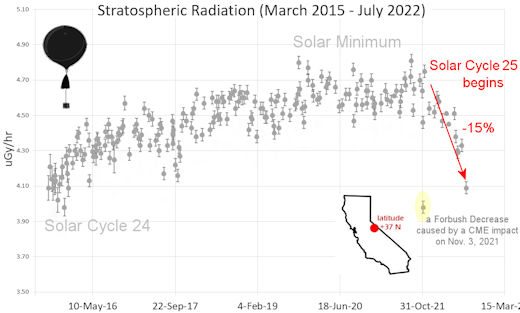
What's going on? Ironically, the radiation drop is caused by increasing solar activity. Solar Cycle 25 has roared to life faster than forecasters expected. The sun's strengthening and increasingly tangled magnetic field repels cosmic rays from deep space. In addition, solar coronal mass ejections (CMEs) sweep aside cosmic rays, causing sharp reductions called "Forbush Decreases." The two effects blend together to bring daily radiation levels down.
.Who cares? Cosmic rays are a surprisingly "down to Earth" form of space weather. They can alter the chemistry of the atmosphere, trigger lightning, and penetrate commercial airplanes. According to a study from the Harvard T.H. Chan school of public health, crews of aircraft have higher rates of cancer than the general population. The researchers listed cosmic rays, irregular sleep habits, and chemical contaminants as leading risk factors. A number of controversial studies (#1, #2, #3, #4) go even further, linking cosmic rays with cardiac arrhythmias and sudden cardiac death.
Technical notes: The radiation sensors onboard our helium balloons detect X-rays and gamma-rays in the energy range 10 keV to 20 MeV. These energies span the range of medical X-ray machines and airport security scanners.
Data points in the graph labeled "Stratospheric Radiation" correspond to the peak of the Regener-Pfotzer maximum, which lies about 67,000 feet above central California. When cosmic rays crash into Earth's atmosphere, they produce a spray of secondary particles that is most intense at the entrance to the stratosphere. Physicists Eric Regener and Georg Pfotzer discovered the maximum using balloons in the 1930s and it is what we are measuring today.
| | The official U.S. government space weather bureau |
| | The first place to look for information about sundogs, pillars, rainbows and related phenomena. |
| | Researchers call it a "Hubble for the sun." SDO is the most advanced solar observatory ever. |
| | 3D views of the sun from NASA's Solar and Terrestrial Relations Observatory |
| | Realtime and archival images of the Sun from SOHO. |
| | information about sunspots based on the latest NOAA/USAF Active Region Summary |
| | current counts of failed and deployed Starlink satellites from Jonathan's Space Page |
| | Authoritative predictions of space junk and satellite re-entries |
| | from the NOAA Space Environment Center |
| | fun to read, but should be taken with a grain of salt! Forecasts looking ahead more than a few days are often wrong. |
| | from the NOAA Space Environment Center |
| | the underlying science of space weather |
 | When looking for casinos to play online when the weather is bad, you can try the SkyCity Online Casino if you are located in New Zealand. If you are not from NZ you can try the Swedish page Svenska casino online to find suitable games, check out svenskacasinoonline.net. Always check your local laws before playing with real money.. |
 | BestCSGOGambling is the best site for everything related to CSGO gambling on the web |
| | These links help Spaceweather.com stay online. Thank you to our supporters! |
| | | | | | |

